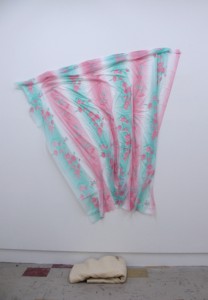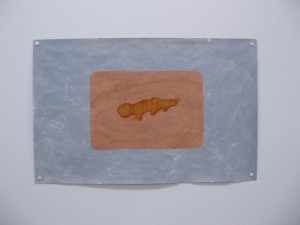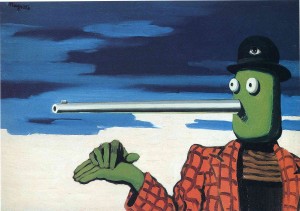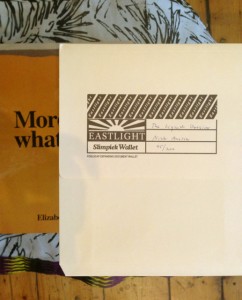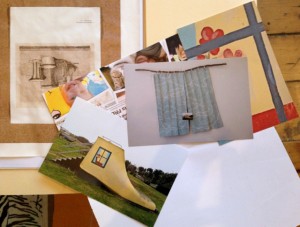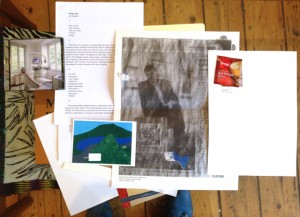I think it was in 2006 that we at TCB art inc. decided to invite Rebecca Ann Hobbs, based in Auckland at the time, to curate a show at the gallery. We were keen to mix up the programming and eager to see things we might not otherwise see.
I
How to look
well, feel well:
First, you need
to find a
routine.
The exhibition One for the ‘other’ ended up being like a convoluted gift. Rebecca, herself invited, in turn invited fourteen of her favourite men to exhibit alongside her. Among them were Melbourne-based artists, friends and colleagues of ours and hers: Nick Selenitsch, Paul Knight, Christopher Koller, Brendan Lee and Kiron Robinson. The others were artists based elsewhere, mostly New Zealand, perhaps one in LA (1).
Three Nicks in one show.
Nick Selenitsch, whom I didn’t really know well at the time, assisted installing the works— quiet logic and confident ease.
I remember opening a homemade foam core box from Michael Lett as if it were a present, a gift. Upon opening I found a set of instructions, a woollen blanket and a $2 shop-esque thin plastic decorated tablecloth.
1. Rub blanket on wall
2. Spread tablecloth on wall.
Simple instructions, alongside a simple diagram, Untitled, by Simon Denny.
3. Fall in love with static electricity.
I lie. The third instruction does not exist. Perhaps saying it, overstates it.
If my memory serves me correctly, Nick Austin’s work arrived in a tube. Unrolling a carefully wrapped and painted tabloid double-page spread has a particular material quality to it: the newspaper and paint somehow merge to become another material—softer, more fragile, more plastic.
Note: Fall in love again.
The scumbled surface of Austin’s painting left only remnants of the daily dealings below its surface. Eliciting a kind of banal-melancholic humour, Austin’s painting A rhizome (2006) depicted a small piece of ginger (or was it tumeric?) contained by an almost-sloppy-peachily-painted round-edged-rectangle.
Quotidian beauty.
Jon Bywater might say, ‘As if to say: if that’s what you’re looking for, don’t look for it in the canvas. It highlights instead their simplifications, the analytical, human character of the act of painting’.
A couple of weeks ago, someone asked me who my favorite artist was. A strange question to which I am usually hesitant to respond—the answer can seem to be transient and allusive to both the questioner and questionee. Deciding to commit. If only allowed one, the parameters were set, I would say Nick Austin.
I said, ‘Nick Austin’.
Across the Tasman Sea, aided by intermittent internet searches and the occasional exhibition in Melbourne, I can be a fan. Electing Austin as a favorite, not the Firefox kind, means I might get to share some of his historical friends—Morandi, Cezanne, Giotto, Piero della Francesca—and wonder, would he share mine? Tony Clark, Vermeer or Sophie Tauber-Arp. What of Bonnard? De Stael? John Brack? What does he think of wacky Magritte paintings such as The ellipsis (1948)? Does he like Patrick Lundberg’s shoelaces?
Funny formalism for lovers. Empty absurdity for wanna-be vagabonds.
Hey Lane! Hey Col! Hey Moo! Who was that Mannerist that lived in the tree?
About a month ago, after some brief email conversations with Helen from Parsons’ Library Supply, credit card numbers and expiry dates, I received in the mail The liquid dossier.
Handwritten 45/200.
No expectations.
A humble-but-eluding-to-order Eastlight. Slimpick. Wallet. Foolscap in fact, Manila folder yellow in colour. Contained within it, an unbound book. A package. Some loose thoughts. Some points to, some points from—trajectories. Personal paraphernalia. Personable.
A list of items contained within—a room-sheet for a folder. A poster, a laser print, a risograph, photographs printed and enveloped in the equivalent of an Officeworks envelope. A very short PowerPoint film called Dentists on holiday with an improvised-jazz–accompanied-by-an-engine soundtrack on a DVD in a crystal case. A small sachet of coffee the size of a photo depicting a coffee cup the size of a small car. A postcard of a painting of an envelope flying.
Envelopes inside envelopes. Unread … no … wait … cannot be opened mail.
The green notebook was a gift, Jon Bywater writes.
He goes on: I find ways to use it as well as the laptop on which I usually write; sometimes, of course, just because it’s easier to carry and the only thing to hand, but it also creates a loose genre of notes.
The package is im or I’m perfect. And quirky in its everyday-ness, in its dossier-ness, rather than its archive-ness. This is like Christopher LG Hill’s Endless lonely planet or Jon Nixon’s Mike Brown research volumes 1 and 2.
But also not.
A very short letter to Bonnard dated 13 August 1925 reads:
Long Live
Painting!!!
In Friendship
Likened to what Patrick said, maybe our interest can lie in ‘a more social painting. A painting with a keener sense of duration. A painting which one day may no longer beg to be called by that name’.
A book with a keener sense of time, a book which one day may no longer beg to be called by that name.
(1) One for the ‘other’ was curated by Rebecca Hobbs. The artists included in the exhibition were: Rebecca Hobbs, Peter Volich, Phillip Maysels, Nick Selenitsch, Josh Stone, Dan Arps, Christopher Koller, Jon Bywater, Brendan Lee, Nick Austin, Paul Knight, Simon Denny, Kiron Robinson, Mario Garcia Torres and Nick Spratt.
(2) Jon Bywater, ‘Power nap’, in Nick Austin, The liquid dossier, designed by Nick Austin, Gilbert May & Duncan Munro, Lucky Stairs Studio, edn 45/200, published by Nick Austin & Hocken Collections, University of Otago, on the occasion of the exhibition The liquid dossier, Feb. 2013.
